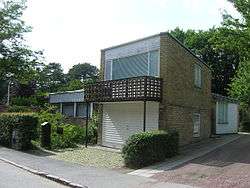Hans Westman
Hans Gustaf Westman (9 March 1905 – 17 November 1991) was a Swedish architect [1]

Biography
Westman was born in the parish of Hökhuvud in Stockholm County, Sweden. After graduating in Uppsala University in 1924, Westman graduated from the KTH Royal Institute of Technology in 1929. He made a study trip to Italy in 1929 and with a scholarship from KTH traveled to Italy and Germany in 1935.
Westman practised as an architect from 1932 until 1983 and was mainly active in Scania. Westman conducted his own architectural firm in Malmö in 1936–38 and then in Lund. In Westmans villa, built in 1939-1940, Westman combines modernism of the time with his own, new thoughts. In addition to housing for his family, it was also furnished to the architect's own office. [2]
His works united regional cultural tradition with functionalism, attempting to create a new, Westmannian regional architecture instead of recreating old models. At the same time, Westman resented functionalists' neglect of the human factor that manifested itself in large scale buildings with routinely applied monotonous patterns. Westman's critique became a driving motive for a humanistic development in architecture of Lund.[3]
Buildings
- Expansion of Saint Eric's Cathedral, Stockholm (1983)
- Bylgiahuset
- Mellanhedsskolan
- Sporthallen (1956)
- Simhallen (1965)
Lund:
- Tingshuset
- Polishuset
- Linnéstaden (1945-1948)
- Tomegapsgatan 13 och 15 (1951)
- Kalmar nation (1952)
- Gothenburg nation "Kållehus" (1951)
- Studentlyckan (1958)
- Parentheses (1962)
- Ulrikedal (1963)
- Delphi (1964-1967)
- Fyrklöverhuset (Delphi, Kämnärsvägen, Gylleholmsvägen)
- Lunds Badhus (1938, rivet 1978)
- Idrottshallen I Lund (1941)
- Villa Westman (1939)
References
- "Hans Gustaf Westman, arkitekt". Vem är Vem? Skånedelen. 1948. Retrieved April 1, 2019.
- "Hans Westmans arkitektvilla i Lund". ravjagarn.se. January 6, 2012. Retrieved April 1, 2019.
- Tomas Tagil. Arkitekten Hans Westman, funktionalismen och den regionala särarten. Lunds Universitas, 1996 ISBN 91-85460-58-3